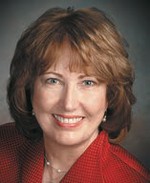Postscript: Principals’ Voices Needed
Strategies to build your voice to get what's best for your students and your school. By Gail Connelly, NAESP Executive Director Principal, September/October 2016 “Of all the items in a principal’s professional toolkit that support success, we think the most important is voice — a voice that is authentic, insightful, considerate, and confident.”
Strategies to build your voice to get what’s best for your students and your school.
By Gail Connelly, NAESP Executive Director
Principal, September/October 2016
 “Of all the items in a principal’s professional toolkit that support success, we think the most important is voice — a voice that is authentic, insightful, considerate, and confident.”
“Of all the items in a principal’s professional toolkit that support success, we think the most important is voice — a voice that is authentic, insightful, considerate, and confident.”
These are the words of Russell Quaglia and Peter DeWitt, whose recent book, Principal Voice: Listen, Learn, Lead, addresses the challenge of principals actually being heard, not just listened to. To have a real impact on student achievement, the authors say, principals’ voices must be informed and supported by the full range of stakeholders.
The theme of principals finding their own voice is a familiar one to members of NAESP. Over the years, we have fought for and traced the evolution of the principal’s role — from one frequently sidelined in policy to one at dead center in conversations about practices and processes that directly affect student achievement. The recently passed Every Student Succeeds Act (ESSA) features an unprecedented level of support for the role of principals, evidenced by the more than six dozen times the term “principal” is mentioned in a meaningful way. The new law has opened up a range of new opportunities for school leaders to lend their voices to state, regional, and local education agencies in collaborative consultations to improve teaching and learning in their schools.
For the past two decades, we have had tangible evidence establishing the direct link between school leaders and student achievement. Now that principals are being given the opportunity and responsibility to play a more central and crucial role than ever before, it’s time to get busy developing that most important tool in your toolkit: your voice.
Understanding how to speak with your authentic leadership voice will be valuable as you begin to work collaboratively in the ESSA-mandated consultations designed to build the learning plans tailored to your school’s and students’ needs.
Some practical tips and advice compiled from NAESP, and Quaglia and DeWitt, include the following:
Speak up and speak out, principals! Let your voices be heard as you seize this rare opportunity to engage in ESSA consultations in your state that will affect your district and your school.
If you’re tired of policy mandating practice, this may be the best opportunity you will ever have to turn that equation around. Use your voice to ensure that what you know works in practice is heeded in policy. Your students will be grateful for your courage and your confidence on their behalf.
In the coming months, look for voices of your school leadership colleagues to be increasingly showcased in this space. At NAESP, we are dedicated to ensuring you are listened to, heard, and impactful.
Copyright © National Association of Elementary School Principals. No part of the articles in NAESP magazines, newsletters, or website may be reproduced in any medium without the permission of the National Association of Elementary School Principals. For more information, view NAESP’s reprint policy.

